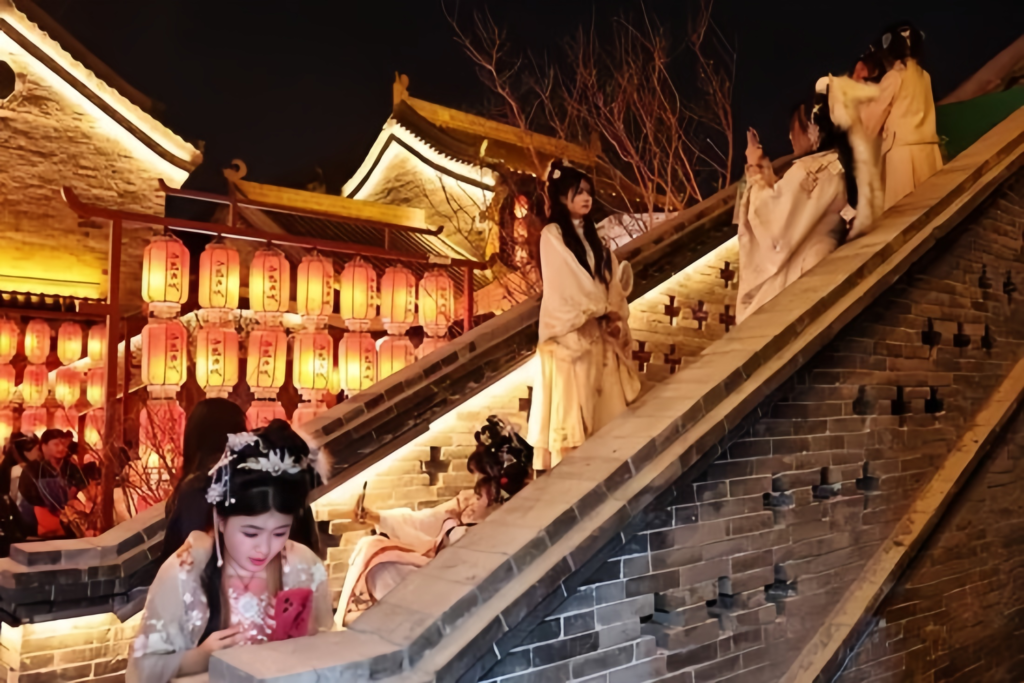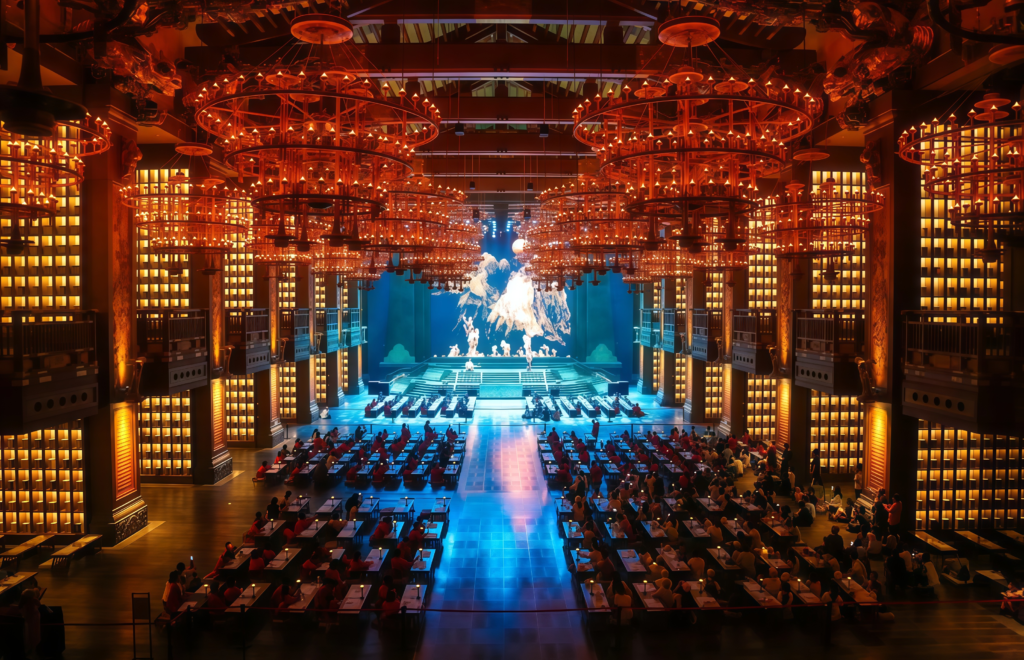5 Reasons Hanfu Travel Is Trending

Picture this: young travelers in flowing hanfu, snapping photos at ancient temples or strolling through vibrant cities. Hanfu travel has taken the world by storm, blending traditional Chinese clothing with modern adventures. From Suzhou’s metro campaigns to Disneyland’s “Chinese princess” moments, wearing hanfu on trips is a growing trend among youth. Why is this cultural revival so popular? In this blog, we uncover five reasons behind hanfu travel’s rise, exploring its charm through stories, history, and style. Let’s dive into the world of hanfu culture!
In recent years, wearing traditional Chinese clothing while traveling has become a major trend among young people. During the Lunar New Year of 2024, Suzhou, Jiangsu, launched a special campaign allowing visitors dressed in traditional Chinese attire to ride the metro for free for a week. The “horse-face skirt” (马面裙) became a must-have festive outfit. Meanwhile, young women wearing hanfu to Disneyland have dubbed it “the perfect princess dress for Chinese girls.” In Quanzhou, Fujian, streets were packed with tourists dressed as Xunpu women, a traditional style dating back to the Eastern Jin dynasty and flourishing in the Ming and Qing periods.
A Celebration of Cultural Identity
Hanfu travel is more than fashion—it’s a proud embrace of heritage. Young people, especially those born in the 1990s and 2000s, are rediscovering traditional Chinese clothing as a way to connect with their roots. Take Zhao Xi, a 27-year-old enthusiast who wore a horse-face skirt to Chengdu’s Wuhou Shrine. “It felt normal, not niche anymore,” she says. This shift reflects a broader cultural revival, with hanfu symbolizing identity at scenic spots like Hangzhou’s West Lake or Suzhou’s gardens. It’s a stylish way to honor China’s 5,000-year history.
Zhao Xi didn’t just wear hanfu in China—she took it overseas too. In Switzerland, she once hailed a taxi while wearing a horse-face skirt, and the driver curiously asked, “Which country are you from?” In Tromsø, Norway, she briefly took off her winter coat to snap a photo in hanfu, and bystanders complimented her outfit, saying, “Your dress is beautiful!” and “You look adorable!”
According to Pan Lusheng, president of the China Folklore Society, the fact that young people—especially those born in the 1990s and 2000s—are embracing hanfu is a great sign of cultural revival. “Many young people today, consciously or unconsciously, are inheriting and passing on traditional culture. You can see this in places like West Lake in Hangzhou or Suzhou’s classical gardens, where students of all ages are wearing hanfu.”
Over the past two decades, Pan Lusheng notes, China’s approach to cultural education has undergone major changes. The younger generation now sees hanfu as a reflection of their cultural identity, making it a stylish and natural choice for travel. This shift, he says, is not forced—it’s an organic return to tradition.
“When people rediscover traditional culture and start incorporating it into both significant events and everyday life, clothing traditions become a natural and meaningful part of modern existence.”

Global Appeal and Curiosity
Chen Chen, a young woman from Hunan, has built an impressive collection of hanfu and carefully selects outfits to match her travel destinations.
For example, she wears flowing robes inspired by the Wei and Jin dynasties when visiting Mongolia’s grasslands and lakes. In Jiangnan’s summer gardens, she opts for a Song-style ruqun (襦裙), which is lightweight and elegant. In Xi’an, a Tang dynasty qixiong ruqun (齐胸襦裙) creates a regal, historical look. When visiting the Forbidden City, she pairs a round-collared robe with a horse-face skirt for a dignified appearance. In Quanzhou, nothing blends in better than the traditional Xunpu woman’s attire, complete with a floral headdress.
When buying hanfu, Chen Chen pays close attention to color, design, and especially the meaning behind embroidered patterns. Her favorite piece is a replica of a Ming dynasty white silk skirt once kept in the Confucius Mansion in Shandong. The fabric features exquisite embroidery of seasonal flowers and birds. “Wearing it makes me feel like a young woman from the Ming dynasty,” she says.
For her, traveling in hanfu isn’t just about taking pretty pictures—it’s about fully immersing herself in history. “It’s different from just renting a costume at a tourist attraction. Wearing hanfu allows me to truly understand the cultural heritage behind these garments and experience the atmosphere described in classical poetry.”
Bi Hong, a master of Beijing embroidery (京绣) and a renowned expert in preserving traditional Chinese clothing, has spent nearly 30 years studying and restoring ancient garments. Her passion began when she stumbled upon a Qing dynasty embroidered robe in an antique shop, an encounter that left a lasting impression. Since then, she has devoted herself to collecting, studying, and preserving imperial Qing dynasty clothing and embroidery techniques.
Her studio houses an old camphorwood chest filled with Qing-era garments and embroidered fabrics she has collected over two decades. She knows the history, fabric types, colors, and meanings behind every single piece.

For Bi Hong, traditional Chinese clothing is more than just fabric and stitches—it carries deep cultural significance. Take, for example, the placement of buttons. “In ancient China, buttons often reflected philosophical beliefs. A traditional robe with seven buttons symbolized the Big Dipper, reminding travelers to find their way home no matter how far they wandered.”
Similarly, embroidery patterns carried hidden meanings. In Qing dynasty court robes, butterflies symbolized joyful reunions, while chrysanthemums represented longevity and nobility. “Traditional embroidery was like a silent language, constantly wishing the wearer good fortune,” Bi Hong explains.
She also emphasizes that traditional clothing wasn’t just about aesthetics—it reflected China’s long history of structured dress codes, designed to harmonize with nature and social customs. “These garments weren’t just about looking good; they embodied an entire way of thinking about life, balance, and identity.”
Destination-Inspired Styling
During the 2024 Lunar New Year, CCTV’s Spring Festival Gala featured a performance showcasing traditional Chinese patterns from the Han, Tang, Song, and Ming dynasties, highlighting the timeless beauty of Chinese clothing.
For Zhao Xi, her love for hanfu initially stemmed from watching historical dramas. At first, most hanfu available was “photo studio style,” with exaggerated designs. But as she learned more, she came to appreciate historically accurate, restored hanfu. “These are designs that have been passed down for centuries. They have stood the test of time, making them truly beautiful.”
While hanfu has become more mainstream, Zhao Xi has noticed some issues—such as shops mislabeling clothing with only minor Chinese elements as “hanfu.” Inconsistencies in design and quality have also become more common as the market grows.
According to Bi Hong, China has long been known as the “Land of Dress and Manners.” Traditional clothing is a historical record of aesthetic trends and a key part of Chinese civilization. She insists that while innovation is welcome, tradition must be respected. “We can modernize hanfu, but we must maintain the core principles of its structure and meaning.”
She believes that spreading awareness and appreciation of traditional Chinese clothing requires time and effort. Exhibitions, lectures, and hands-on experiences can help people of all ages develop a deeper love for traditional culture.
So, how long will the traditional clothing trend last?
“It’s not a question of ‘how long,’” Bi Hong says with confidence. “It will never fade—it will only keep growing.” She sees this revival as more than just a passing trend. “Traditional clothing represents our heritage. No matter how times change, the soul of Chinese culture will never disappear.”
Ultimately, she hopes that one day, exquisitely crafted traditional Chinese clothing will stand proudly on the global fashion stage, making it an honor for people around the world to own and wear “the most beautiful Chinese garments.”

Symbolism in Every Stitch
Traditional Chinese clothing carries profound meaning, making hanfu travel emotionally resonant. Chen Chen loves her Ming dynasty-inspired skirt with embroidered flowers and birds, feeling like a historical figure when wearing it. Experts like Bi Hong, a Beijing embroidery master, explain that details matter—seven buttons on a robe symbolize the Big Dipper, guiding travelers home, while butterflies signify joyful reunions. These layers of significance elevate hanfu beyond aesthetics, appealing to buyers seeking authentic hanfu culture. Learn more about Chinese textile symbolism at The Metropolitan Museum.
Join the Hanfu Travel Movement
Hanfu travel is a vibrant blend of style, heritage, and adventure, capturing hearts worldwide. From cultural pride to symbolic designs, these five reasons show why traditional Chinese clothing resonates with young travelers. Whether you’re a buyer seeking the perfect horse-face skirt or an enthusiast planning a hanfu-themed trip, this trend invites you to celebrate hanfu culture. Explore our collection and let hanfu elevate your next journey! For further reading, check out this scholarly article on Chinese fashion.





Responses